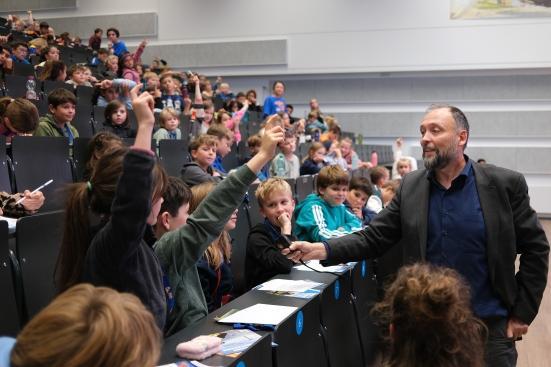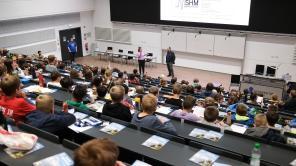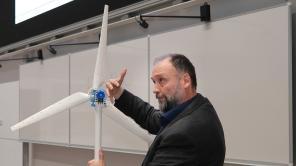Children's university: generating electricity at a height of 160 meters

"Future energy" was the main topic of the fall season of the Siegen Children's University. Prof. Kraemer familiarized his young audience with wind turbines.
How does a wind turbine work? Prof. Dr.-Ing. Peter Kraemer (Mechanical Engineering) had this question for the last event of the autumn season of the Siegen Children's University. On the fourth day of the event, the coveted children's university diplomas and the participation stamp were awarded right at the start.
Peter Kraemer brought along film sequences and a small model of a wind turbine. The films showed the inside of a wind turbine and he used the model to explain the functions of the rotor blades.
When asked at the beginning what the task of such a turbine is, the eight to twelve-year-olds' fingers shot up in the air: "Generate electricity." How is such a turbine constructed? Three rotor blades surround a so-called "nacelle" in which the generator is located. Kraemer: "It's all on a tower." How high is this tower? The children's answers ranged from 10 meters to 500 meters. Most towers currently have a height of 120 - 160 meters. Rarely, there are also turbines with a tower height of around 200 meters. Windmills have been around for about 3000 years. In ancient Persia, they were used to grind grain and as irrigation systems.
A modern wind turbine tower has a diameter of around 6 to 10 meters. However, there are also turbines with a larger tower diameter on the ground. Some towers are equipped with elevators. It is rather cramped in the nacelle. And it is quite warm there. The nacelle of a modern wind turbine weighs 200 - 600 tons. Wind turbines have three blades because this is an optimum compromise between maximum energy yield, stability and cost-effectiveness. The rotor blade is the main component for converting wind power into mechanical energy. A rotor blade of a modern onshore turbine weighs between 12 and 25 tons. However, the rotor blades of offshore turbines can weigh much more. They are usually made of glass fiber composite materials. The rotor blades turn a shaft in the nacelle. This rotary motion is later converted into electricity in the generator. A generator is therefore a machine that converts mechanical energy into electrical energy. Large wind turbines on land cost between 1.3 and 6 million euros. Large turbines operate more economically than small ones.
What happens when there is too much wind? Kraemer: "Then the rotor blades turn out of the wind to reduce the rotor speed and the associated mechanical load on the turbine."
Around 60 percent of electricity in Germany comes from renewable energies. Wind power is the most important component of this. In 2024, wind power produced 136.4 terawatt hours of electricity. One terawatt hour corresponds to one billion kilowatt hours.

